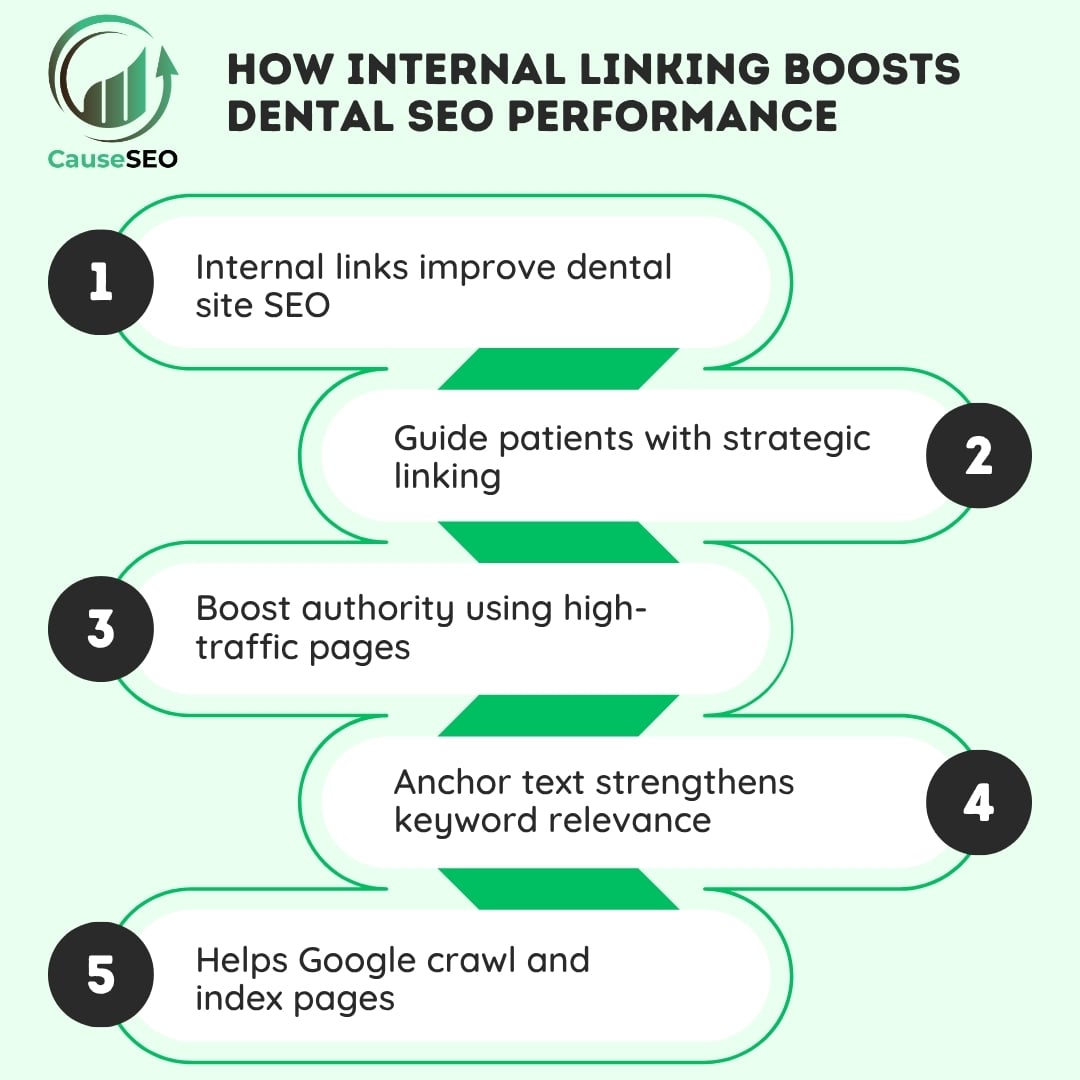Understanding internal linking in dental SEO is essential for dentists who want to boost rankings and guide patients smoothly through their websites. Internal linking is one of the most overlooked parts of dental SEO, yet it plays a key role in how patients—and search engines—navigate your website.
In simple terms, internal links are connections between one page of your site and another. While external links from other websites often get more attention, internal links are fully under your control and can directly improve how your site ranks and converts.
For SEO for dental practices, a smart internal linking strategy helps Google crawl your site more efficiently, passes page authority to important service pages, and keeps patients engaged longer. In this article, we’ll look at what internal linking is, why it matters, and how dental SEO experts use it to boost traffic and conversions.
What Is Internal Linking in SEO?
Definition and Examples
Internal links are clickable links that lead from one page of your site to another. For example:
- A blog post about “tooth pain at night” linking to your Emergency Dentistry
- Your homepage linking to Dental Implants in Red Bank.
These links help users explore more of your site and give search engines a clearer map of your website’s structure.
How Internal Links Differ from External Links
- External links come from other websites and point to your domain.
- Internal links stay within your website. They connect your own content and are easier to manage.
That control is what makes them such a valuable part of your dental website SEO strategy.

Why Internal Linking Matters for Dental SEO
Helps Google Crawl and Index Your Website
Google uses internal links to discover and understand the layout of your site. Pages that aren’t linked from anywhere else can easily be missed, especially if they’re deeper in the site structure.
Linking to these pages ensures they get crawled, indexed, and show up in search results—especially important for service and location pages.
Passes Page Authority (Link Equity)
Internal links help distribute “link equity” across your site. A high-authority page like your homepage can share some of its value by linking to other important pages.
Example: Linking from your About Us page or a popular blog to your Invisalign in Middletown page gives it a boost in authority—helping it rank higher over time.
Improves User Navigation and Engagement
Clear internal linking helps patients find what they need quickly. Someone reading about “dental anxiety” can easily navigate to your Sedation Dentistry page. This kind of guided navigation:
- Reduces bounce rates
- Increases time-on-site
- Signals relevance and usability to Google
Supports Keyword Relevance and Topical Authority
Using strategic anchor text (the words you hyperlink) helps reinforce keyword themes. For example, linking the phrase “pediatric dental services” to the correct page builds topical strength. It also helps Google understand what that page is about.
When you consistently link related blog posts and service pages, you create clusters of content around core topics—something Google rewards.
Best Practices for Internal Linking in Dental Websites
Use Descriptive Anchor Text
Anchor text should clearly describe what the linked page is about. Avoid vague phrases like “click here.” Instead, use context-rich phrases like:
- “Explore our pediatric dentistry services”
- “Learn more about teeth whitening options in Red Bank”
Link From High-Traffic Pages to Priority Pages
If you have a blog post that gets regular traffic, use it to link to a page that doesn’t get as many visits but is important—like a high-value service page. This helps distribute attention and authority more effectively.
Maintain a Clean Link Structure
Don’t go overboard. Too many links on a single page can feel spammy and confuse both readers and search engines. Keep your links:
- Relevant to the topic
- Natural in placement
- Spaced out within the content
Ensure Important Pages Are Within 2–3 Clicks
A key SEO principle: no important page should be buried. Every critical page—like services, contact, or about—should be reachable in just a few clicks from your homepage.
Use Navigation, Footer, and In-Content Links Wisely
- Navigation links guide broad site structure.
- Footer links can highlight secondary but useful content like FAQs or locations.
- In-content links within blogs and service pages provide contextual guidance and strengthen topic relevance.

Tools and Methods to Improve Internal Linking
Audit Tools
Tools like Ahrefs, Screaming Frog, and SEMrush can scan your site and show which pages are poorly linked or not linked at all. These are often called “orphaned pages” and are missed opportunities for SEO performance.
These tools also help visualize how your internal links flow—so you can spot gaps and make improvements.
Manual Review and Content Planning
A good dental SEO expert doesn’t just rely on tools—they manually assess content for strategic link placements. As new blogs or services are added, they look for ways to connect them naturally to existing content.
Regularly updating your site gives you ongoing chances to strengthen your internal link structure.
Common Internal Linking Mistakes That Hurt SEO
Over-Optimizing Anchor Text
Using the exact same keyword-rich anchor text in every link can look unnatural. Instead, vary your anchor phrases. Use combinations of:
- Partial match: “Invisalign for adults”
- Branded: “ABC Dental’s Invisalign options”
- Generic: “Learn more”
Linking to Irrelevant Pages
Every link should serve a purpose. Don’t force a connection if it doesn’t make sense. Irrelevant links confuse users and reduce trust.
Ignoring New Content
Every new blog post or service page should be linked from somewhere on your site. Otherwise, Google may never find or index it. Always ask: where can I connect this to existing content?

FAQs – Internal Linking in Dental SEO
What is internal linking in dental SEO?
Internal linking connects one page of your dental website to another. It helps search engines crawl your site and helps patients find related information more easily.
How many internal links should I add per page?
There’s no fixed number, but 3–5 contextual links per 1,000 words is a good start. Focus on relevance and user flow, not just quantity.
What kind of anchor text is best for SEO?
Descriptive and natural anchor text that tells users what to expect. Avoid overused phrases like “click here.” Use context-specific terms related to your services.
Do internal links help my service pages rank better?
Yes. Internal links can pass authority to service pages, reinforce keyword relevance, and help Google understand their importance—improving rankings over time.
Can I overdo internal linking and hurt my SEO?
Yes. Too many links or overly optimized anchor text can confuse users and look manipulative to search engines. Keep links natural and useful.
How do I find internal linking opportunities on my dental website?
Use tools like Ahrefs or SEMrush to scan for underlinked pages. Or review blog posts manually and look for ways to connect them to service or location pages.
Conclusion
Internal linking is one of the simplest ways to improve your dental SEO—yet it’s often underused. It improves crawlability, strengthens page authority, guides users to the right content, and ultimately helps turn visitors into patients.
As SEO for dental websites continues to evolve, internal linking remains a foundational tactic that supports both search performance and user experience.
Work with a dental SEO expert at Cause SEO, a Winnipeg seo agency, to audit your site and build an internal linking strategy that drives real results.

